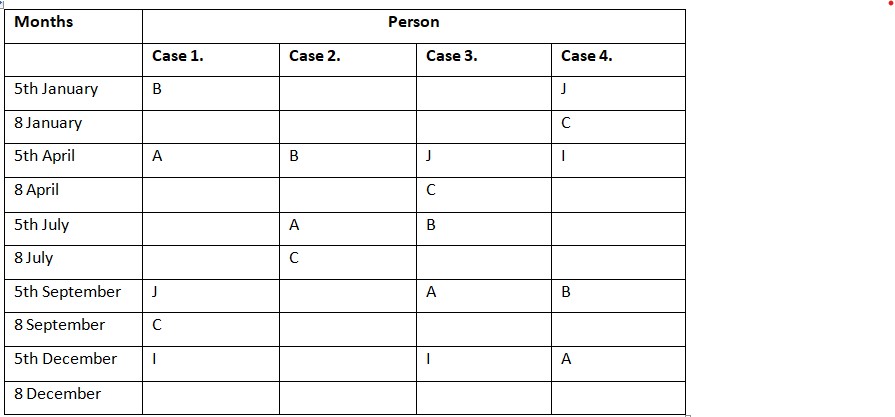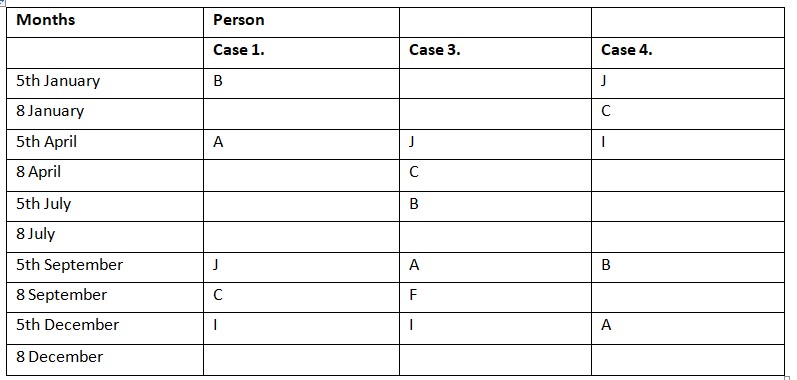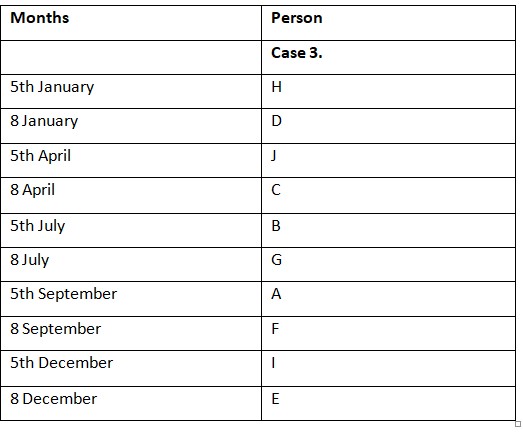Question
Which of the following statement is/are not true?
I) J attends the seminar just after C. II) Three persons attending the seminar between A and J. III) F and G attending the seminar in the same month. Study the following information carefully and answer the below questions. Ten persons namely –A, B, C, D, E, F, G, H, I, and J attend a seminar event in five different months viz.- January, April, July, September, December. Seminar in each month was scheduled on the 5thrd and 8th of the month. All the information is not necessary in the same order. The number of persons is attending a seminar after A is the same as the number of persons is attending the seminar before C. A attends seminar two months after B, who attends the seminar on an odd date. C and J attend the seminar in the same month. The number of persons is attending the seminar between J and B is the same as the number of persons is attending the seminar between A and I. The number of persons attending the seminar between F and C is one less than the number of persons is attending the seminar between H and G. F attends seminar three months before I, who attends seminar in one of the months has 31 days. G attends seminar on the 8th of the month but not in January. H and D attend seminars in the same month. At least two persons attend the seminar between E and A.Solution
The number of persons is attending a seminar after A is the same as the number of persons is attending the seminar before C. A attends seminar two months after B, who attends the seminar on an odd date. C and J attend the seminar in the same month. We will have four cases: If B attends seminar on 5th January, then A will attend on 5th April. C will attend on 8 September and J will attend on 5th September. If B attends seminar on 5th April, then A will attend on 5th July. C will attend on 8 July but we do not have dates for J. If B attends seminar on 5th July, then A will attend on 5th September. C will attend on 8 April and J will attend on 5th April. If B attends seminar on 5th September, then A will attend on 5th December. C will attend on 8 January and J will attend on 5th January.  The number of persons is attending the seminar between J and B is the same as the number of persons is attending the seminar between A and I. In case 1, there are five person between B and J. So, I attends seminar on 5th December. In case 3, there is one person between B and J. So, I attends seminar on 5th December. In case 4, there are five person between B and J. So, I attends seminar on 5th April. F attends seminar three months before I, who attends seminar in one of the months has 31 days. Case 1 and 4 will get discarded as we know that I attends the seminar in December and F should have attended in September. In case 3, F attends seminar on 8 September.
The number of persons is attending the seminar between J and B is the same as the number of persons is attending the seminar between A and I. In case 1, there are five person between B and J. So, I attends seminar on 5th December. In case 3, there is one person between B and J. So, I attends seminar on 5th December. In case 4, there are five person between B and J. So, I attends seminar on 5th April. F attends seminar three months before I, who attends seminar in one of the months has 31 days. Case 1 and 4 will get discarded as we know that I attends the seminar in December and F should have attended in September. In case 3, F attends seminar on 8 September.  At least two persons attend the seminar between E and A. So, E attends seminar on 8 December. G attends seminar on the 8th of the month but not in January. Now it is clear that G attends the seminar on 8 July. The number of persons attending the seminar between F and C is one less than the number of persons is attending the seminar between H and G . H and D attend seminars in the same month. We know that three person are there between F and C. It means that there would have been four person between G and H. So, H and D attend seminar on 5th January and 8 January respectively. Final arrangement as shown below:
At least two persons attend the seminar between E and A. So, E attends seminar on 8 December. G attends seminar on the 8th of the month but not in January. Now it is clear that G attends the seminar on 8 July. The number of persons attending the seminar between F and C is one less than the number of persons is attending the seminar between H and G . H and D attend seminars in the same month. We know that three person are there between F and C. It means that there would have been four person between G and H. So, H and D attend seminar on 5th January and 8 January respectively. Final arrangement as shown below: 
What was the theme of World Food Safety Day 2025?
The Reserve Bank of India (RBI) has permitted non-banking finance companies operating as Infrastructure Debt Fund (IDF-NBFCs) to raise money through ext...
Who was conferred with the 19th ‘Kalakar Puraskar’ for achievements in Konkani music, dance, theatre, folklore, and cinema?
What is the unique feature of Ambasamudram Choppu Samaan that earned it a GI tag?
What significant change did LIC make in its framework, as per the Life Insurance Corporation of India (shareholders' director) Regulations, 2023?
Which Indian para-athlete won a bronze medal in the 65kg Legend category at the 2025 Para Powerlifting World Championships?
What is the main objective of the 'Samajik Adhikarita Shivirs' organized by the Ministry of Social Justice and Empowerment, Government of India, across ...
According to the data provided by CRISIL, India’s investments in infrastructure will rise to Rs 143 trillion between financial years 2024 and 2030.CRI...
Who has been selected for the ICC Men’s Cricketer of the year 2022?
Which country is home to the Ibu Volcano, which made headlines in recent news?
Relevant for Exams:



